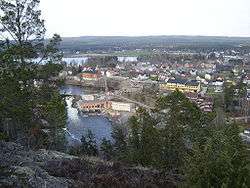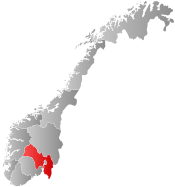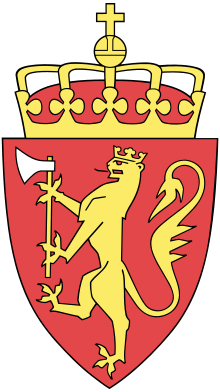Marker, Norway
Marker is a municipality in Viken county, Norway. The administrative centre of the municipality is the village of Ørje. Marker was created as a new municipality on 1 January 1964 following the merger of the two former municipalities of Rødenes and Øymark.
Marker kommune | |
|---|---|
 | |
 Coat of arms  Viken within Norway | |
 Marker within Viken | |
| Coordinates: 59°30′40″N 11°37′42″E | |
| Country | Norway |
| County | Viken |
| District | Smaalenene |
| Administrative centre | Ørje |
| Government | |
| • Mayor (2003) | Kjersti Nythe Nilsen (Ap) |
| Area | |
| • Total | 413 km2 (159 sq mi) |
| • Land | 368 km2 (142 sq mi) |
| Area rank | 235 in Norway |
| Population (2004) | |
| • Total | 3,409 |
| • Rank | 250 in Norway |
| • Density | 9/km2 (20/sq mi) |
| • Change (10 years) | 2.0% |
| Demonym(s) | Marking[1] |
| Time zone | UTC+01:00 (CET) |
| • Summer (DST) | UTC+02:00 (CEST) |
| ISO 3166 code | NO-3013 |
| Official language form | Bokmål[2] |
| Website | www |
The municipality borders Sweden, Aurskog-Høland municipality in Akershus county, and Aremark, Eidsberg, Rakkestad, and Rømskog municipalities in Østfold county. European route E18 passes through the municipality.
The municipality's biggest attractions are the fortresses at Basmo and Ørje. Basmo Fortress lies on an isolated mountain outcrop between lakes Rødenessjøen and Hemnessjøen in the northwestern part of the municipality.
General information
Name
The Norse form of the name was Markir, which is the plural form of mǫrk f 'woodland, borderland' (see > March).
Coat-of-arms
Marker's coat-of-arms dates from modern times, having been granted on 16 April 1982. The arms show two white-colored trunk-hooks on a blue background. They are a type of hook, normally on a long pole, used to drive tree trunks through the rivers. The main economic activity in the municipality is forestry, hence the use of the hooks. The two hooks also represent the two villages (and former municipalities) of Rødenes and Øymark.[3]
Rødenes church
Rødenes church (Rødenes kirke) is a medieval-era church in the Rødenes parish of Marker. It belongs to Østre Borgesyssel deanery in the Church of Norway's Borg Diocese. The building, which is of Romanesque architectural style and dates from 1230, has a rectangular nave and a lower and narrower choir. The oaken pulpit dates from the 1600s and the altarpiece from the 1720s. The edifice is of stone and brick. The floorplan is long and has room for 240 seats. The church underwent extensive reconstruction in the years 1703–1709 and again in 1949–1952.[4] [5]
Minorities
| Ancestry | Number |
|---|---|
| 74 | |
| 37 | |
| 25 | |
| 17 | |
| 14 | |
References
- "Navn på steder og personer: Innbyggjarnamn" (in Norwegian). Språkrådet.
- "Forskrift om målvedtak i kommunar og fylkeskommunar" (in Norwegian). Lovdata.no.
- Norske Kommunevåpen (1990). "Nye kommunevåbener i Norden". Retrieved 2008-12-15.
- "Rødenes kirke". Den Norkse Kirke. Retrieved October 1, 2016.
- "Østre Borgesyssel prosti". arkivportalen. Retrieved October 1, 2016.
- "Immigrants and Norwegian-born to immigrant parents, by immigration category, country background and percentages of the population". ssb.no. Archived from the original on 2 July 2015. Retrieved 29 June 2015.
External links
| Wikivoyage has a travel guide for Marker. |


- Municipal fact sheet from Statistics Norway
- Culture in Marker on the map (in Norwegian)

